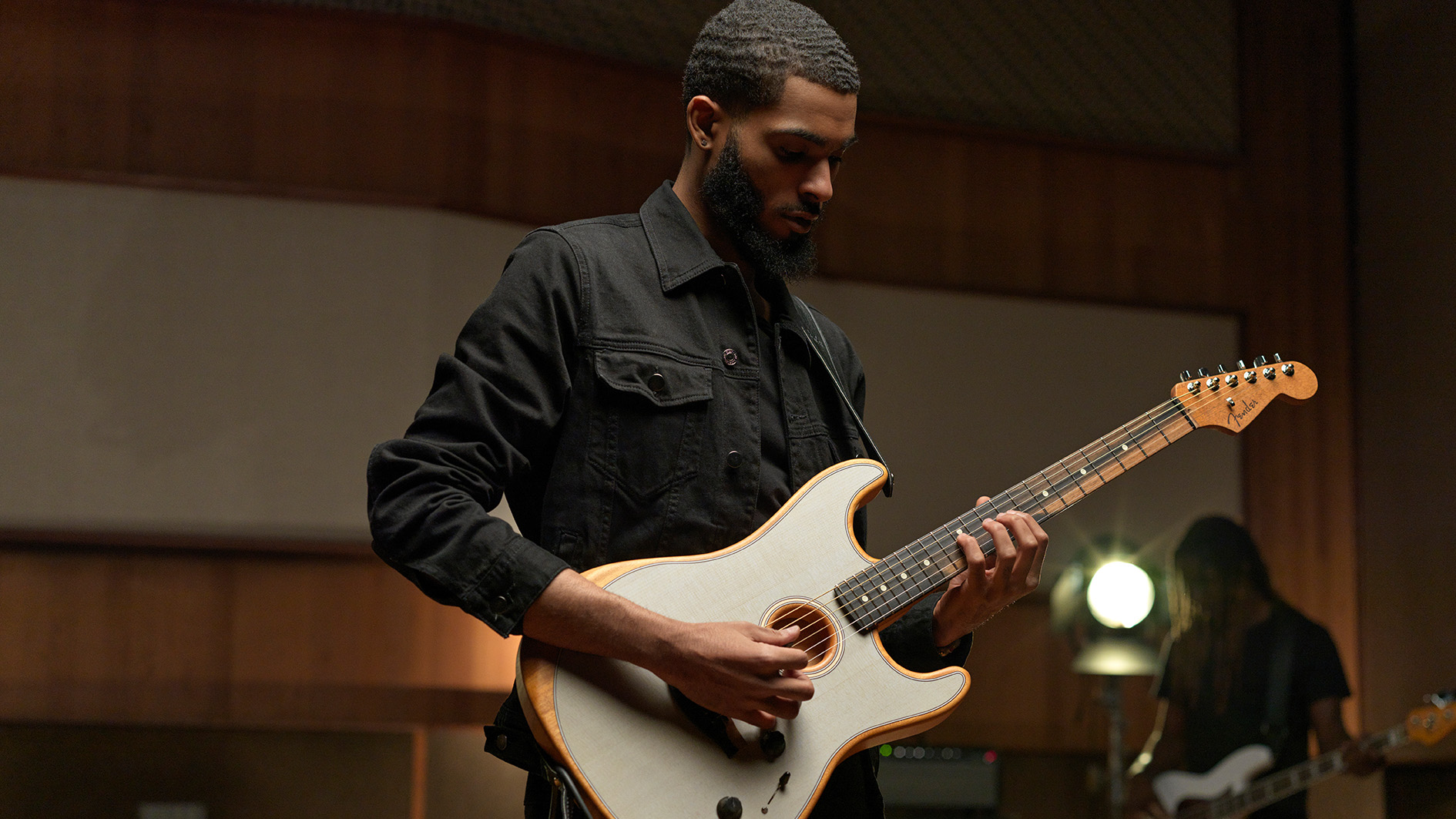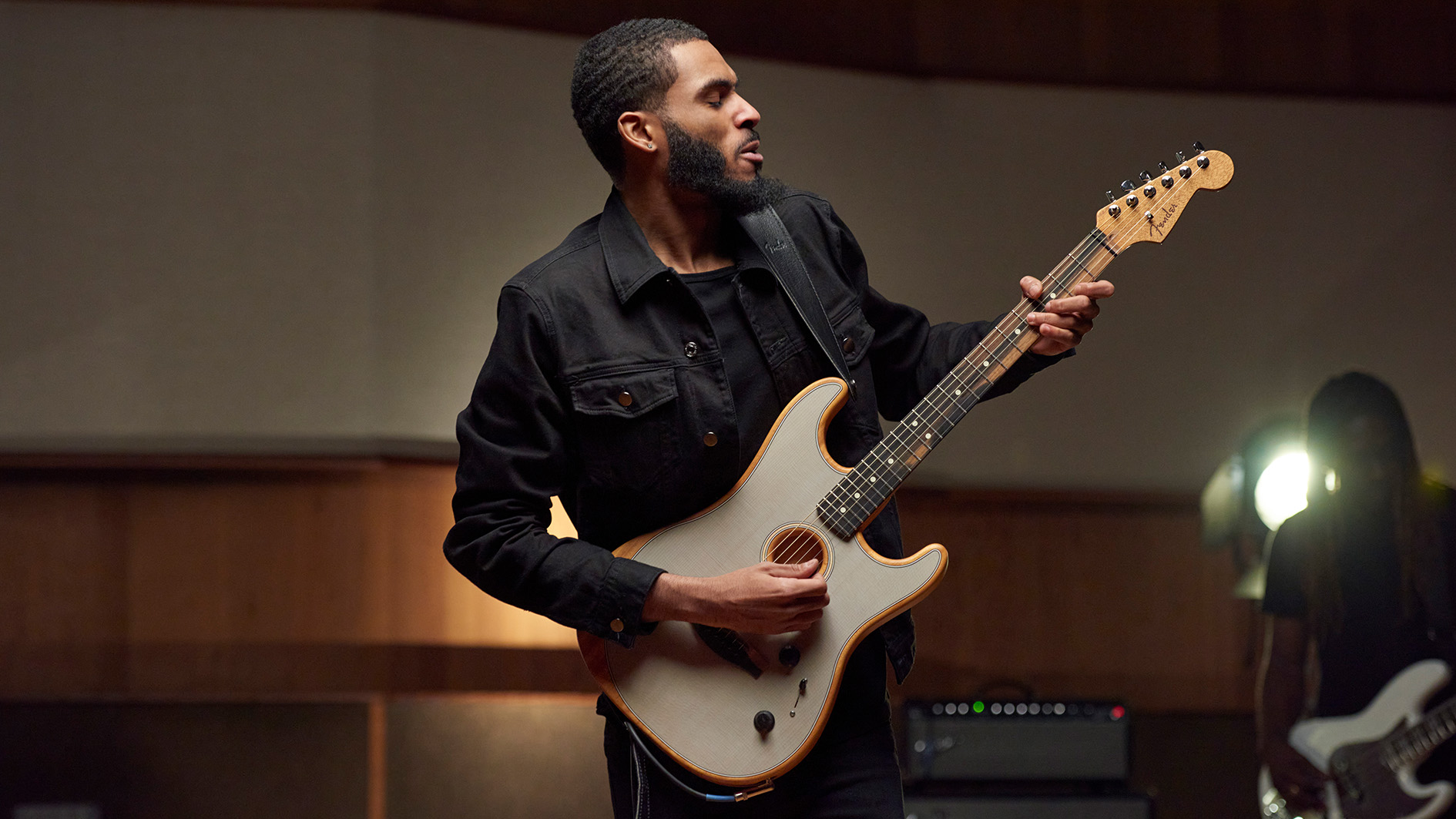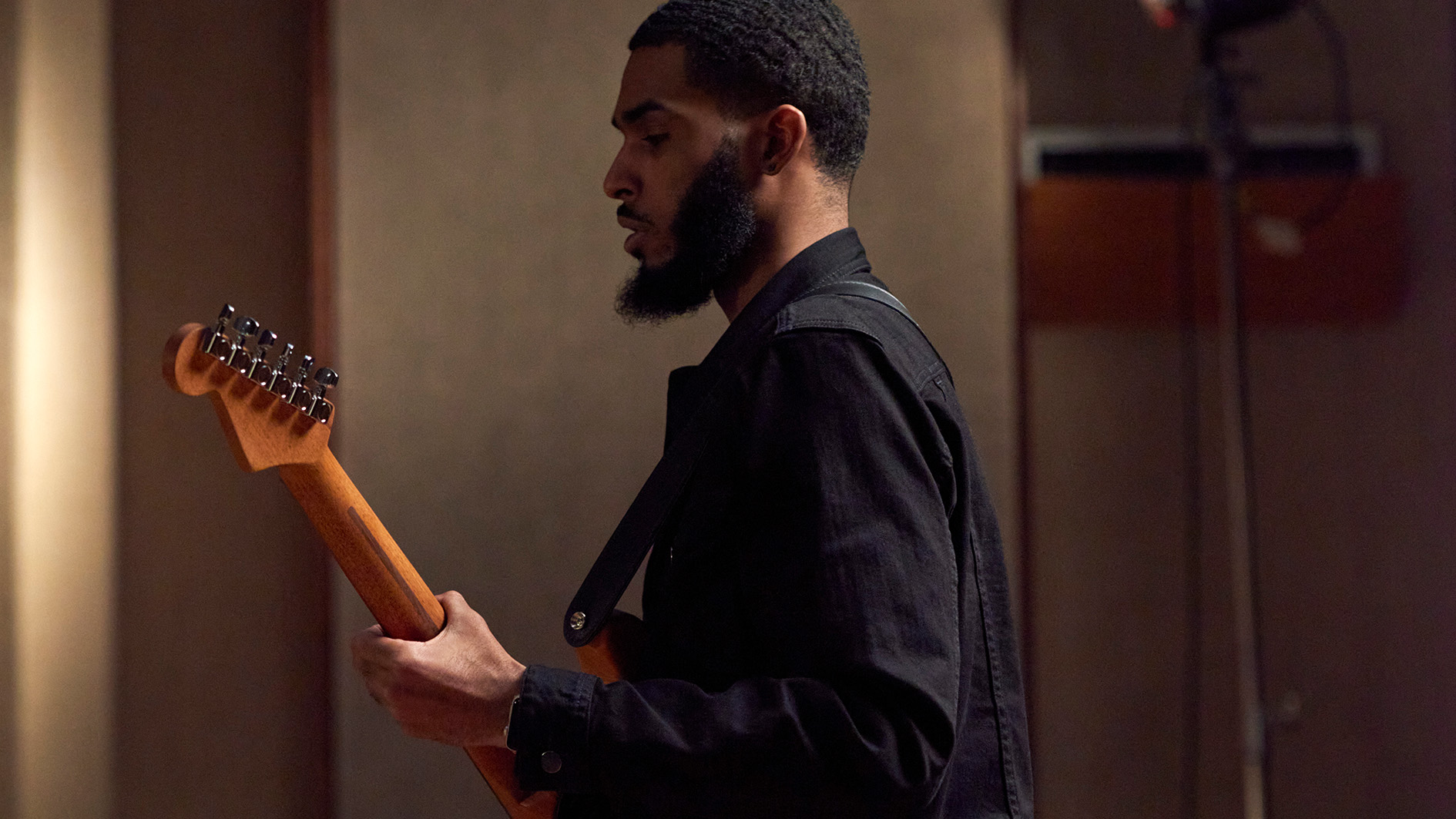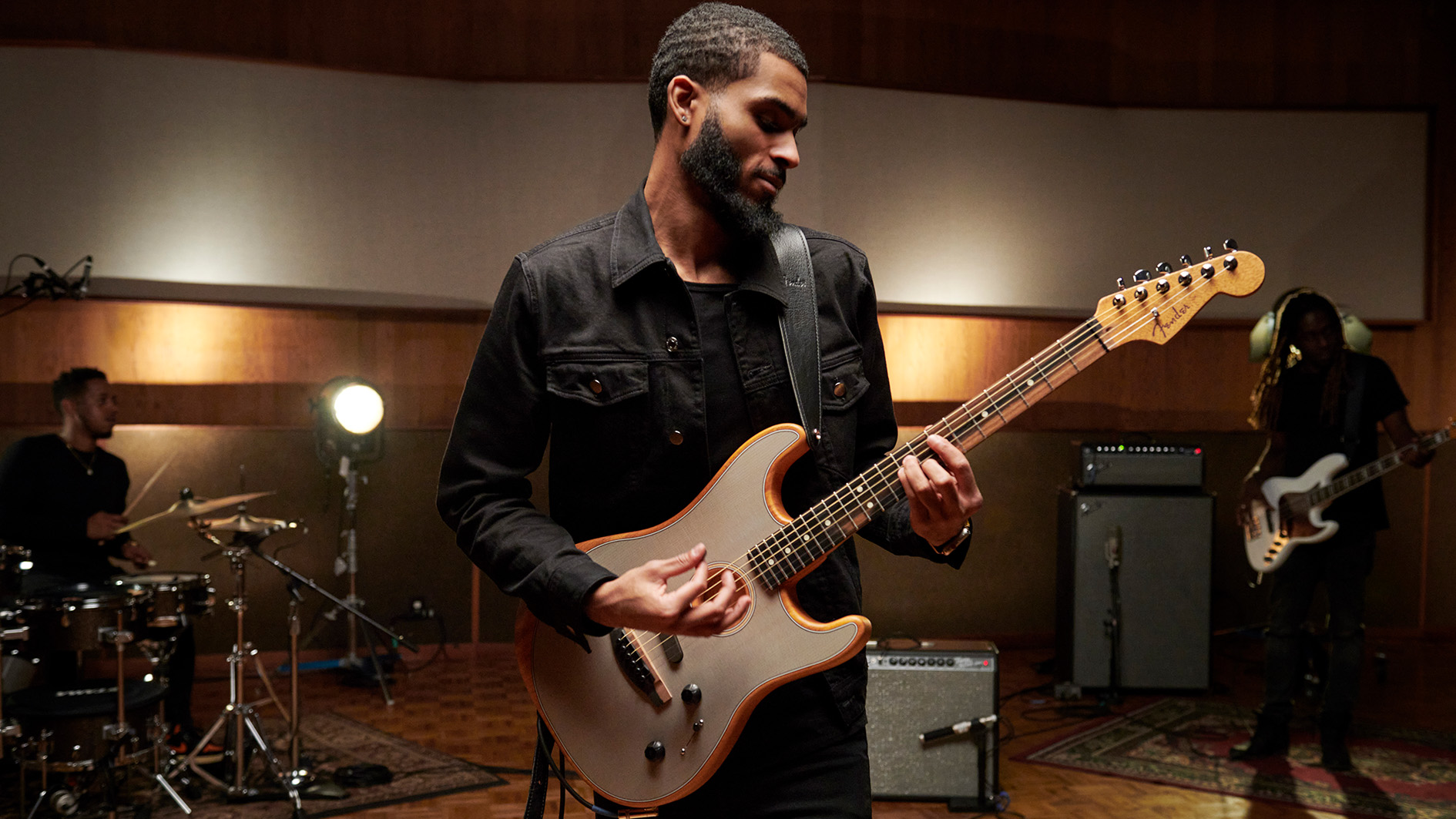Kendrick Lamar guitarist Rob "Freaky Rob" Gueringer: "Remember that when you are working with these artists, you are an artist as well"
He's toured with Eminem, Cardi B, Usher and Mac Miller. Now, "Freaky Rob" tells GW how he became one of hip-hop's most in-demand guitar players - and the face of Fender's American Acoustasonic Stratocaster

Fender have always led the charge when it comes to innovation and their latest creation, the American Acoustasonic, is no exception. As expertly demonstrated by Rob "Freaky Rob" Gueringer - lead guitarist for Kendrick Lamar and Lil Wayne - in last month’s promotional video, it’s a hybrid instrument that propels two of their most famous inventions to new uncharted tonal heights.
Half electric and half acoustic, these daring designs turned heads upon its announcement at NAMM back in January, and are now available worldwide in both Stratocaster and Telecaster forms.
“That Acoustasonic performance will always be a crazy one for me,” admits Gueringer, looking back on the live performance that went out through all of Fender’s official channels. “This is the kind of thing I’ve wanted to do ever since I picked up the guitar around the age of 12 or 13.
"The most exciting thing about it all was that my rep told me that the performance could be anything I picked. Normally when you get a big opportunity like this, you get boxed into things they already have and ideas they want you to stick to. So I literally got to do something for my all-time favorite guitar company and demo a new guitar - and not just any guitar but an acoustic version of a guitar that was already very, very famous… the Stratocaster!
"To be very honest, I absolutely loved the Acoustasonic. It’s something different for sure and has all the sound qualities of the most high-end acoustics ever made!
“I do occasionally play some other guitars too just because I have to be equipped enough to do whatever the job calls for, but to be honest Fender is where my heart is. My favorite guitar is not a Strat, believe it or not, it’s a Jazzmaster. I also love my Thinline Tele with humbuckers in it. Those are my two favorite guitars of all-time.”
Here Gueringer looks back on his career so far, telling Guitar World about how he became the go-to guitarist for the hip-hop elite, as well as the gear he’s relied on for the biggest shows a session musician can land...
Get The Pick Newsletter
All the latest guitar news, interviews, lessons, reviews, deals and more, direct to your inbox!

Where did your musical journey begin?
“I got into music because of my grandfather. He passed away at the end of last year. He was my best friend in life and he was the very first person to put music into my ears.
"He played bass and guitar, while I started out on drums around the age of two and played that for about 10 years. Then he gave me my first guitar, it was a Squier Bullet Strat or something like that. Once he saw I was serious, he gave me a Custom Shop 1961 Reissue Strat that was actually made in 1991.
"I got that guitar once I’d graduated from eighth grade and was going to high school - which is when my guitar playing kicked into the main gears. I could not put my guitar down. I still carried on playing drums, as well as bass, but what did it for me was the fact I could hold down a chord.
"With drums, you get rhythmic patterns and the same kind of tones. Even with bass, it was more about single notes. When I picked up a guitar, it felt like I was an ensemble. So from my freshman year all the way through high school, I was eating and sleeping guitar. It was a crucial time in my development.”
Which players do you think were the most influential on your style and approach?
Guitarists can be great influences but I take more from other instruments, whether that’s piano or trumpet or anything
“As far as personal guitar players go, there are two - my grandfather and Isaiah Sharkey, who is from the Chicago area. I’m born and raised Chicago too, I met him at a live recording session and he took me under his wing. Right now he plays for John Mayer and D’Angelo, as well as being an artist in his own right. He was one of the first people to sit me down and show me all the different chords.
"The more I played, the more I realized I had perfect pitch... which was a gift and a curse! I didn’t really know what it was, but I noticed I could hear things easier than other people. And that actually made me a weaker music reader, because my ear was so good. Then there was George Benson, Al Di Meola... There’s a new guy called Tim Henderson who I think is super-cool.
“I’m a super-old soul - I mean, honestly, my grandfather was my best friend. So I had a natural ear for jazz and soul. Django Reinhardt is one of my favorite players of all-time. Then there’s Larry Carlton and even saxophone players like Canonball [Adderley].
"Guitarists can be great influences but I take more from other instruments, whether that’s piano or trumpet or anything. Whenever people ask me where I learned how to play bebop, I don’t really know what to say, but having perfect pitch really helped because I play what I hear.”

How exactly did you become one of the biggest session guitarists in hip-hop?
“All that stuff happened when I moved to California around 18 years old. It was just a few months after I graduated in 2014. My roommate in Chicago moved here trying to pursue the same kind of career a few years before me.
"Initially I was going to MI and I noticed they were having open auditions almost every other week. Quincy Jones had an artist called Tommy Ward, he came to the school and I went for it on bass and drums because the guitar spot had already been filled. Tommy himself actually called me later that evening and said he wanted me to move to Vegas with him.
"Me being young and just cautious of everything, the first thing I did was call my school counsellor - I’d only just got there and had done about three weeks of class. I wanted to speak to someone before I resigned, just to make sure I was doing the right thing.
"And I got told this kind of gig was exactly what I was going to school for so I ended up saying yes. I went down to Vegas for a few months, we had a residency and it went pretty well. Things got a bit sour towards the end, so I came back to California in July 2015. That’s when my life changed..."
In what way?
I learned all the music and we flew out to New Orleans for the first [Lil] WeezyAna Festival there ever was. That was all in a day or two from walking into that rehearsal room.
“Another brother of mine, Eric Ingram - also from Chicago - called me on a super-hot day. He said, ‘Dude, I need you to get to Center Stage right now!’ which is a very big rehearsal place. He didn’t tell me what it was for, when I got there I realized it was for Lil Wayne.
"He said he didn’t want me to get too hyped up but now I knew he said he needed me to come through. I guess the guitar player they had at the time had a few things he didn’t agree about with the gig. I was only 18 years old so I was like, ‘Whatever I gotta do… I’m on it!’ The first song we did was Lollipop, which was the soundtrack to my life anyway.
"It felt like I blended in very well - it felt like I knew everyone just because they were older musicians I already looked up to. I learned all the music and we flew out to New Orleans for the first [Lil] WeezyAna Festival there ever was. That was all in a day or two from walking into that rehearsal room.”
And that quickly led to your current gig with Kendrick Lamar?
“It happened fast. Two weeks later, my roommate - an amazing drummer called Tony Nicols - called me again. He’d been playing for Kendrick for about a year or two. I could only dream of playing like someone like that. His band were already locked in, he’d had the same people in his band for years. But my roommate was telling me Kendrick wanted to go in another direction and that I should come to rehearsal tomorrow just to scope things out, meet Kendrick and get a feel for everything.
"So I went by and that’s when things got real. I got a call from Kendrick’s Music Director and he said, ‘Yo, bring your guitar, bring your stuff, don’t say nuthin’ just come to rehearsal tomorrow…’ And literally, right from the top, they threw me right into the mix for King Kunta.
"Then Kendrick came in and fuckin’ loses it. He was like, ‘This guy doesn’t look any older than my cousin - how is he playing for me?’ And they told him to give me a chance. So we ran through the show and he said he hadn’t ever seen anything like it.
"I think he was looking for so much more dynamically from the guitar than what he’d had before, some of the things I did he didn’t even know were possible, like making my guitar sound like a synth. Then I brought in a MIDI guitar and was using VST plugins… all this stuff that wasn’t typical of traditional guitar playing.”
The Kendrick gig must have involved some pretty intense jazz chops. Which song was the most challenging?
Kendrick was looking for so much more dynamically from the guitar than what he’d had before. So I brought in a MIDI guitar and was using VST plugins…
“The most difficult track was For Free? - with the crazy piano movement at the beginning. When we were rehearsing, from 10am to 10pm every day, it took a long time to learn and especially for the piano player. We felt so bad for the guy - we actually left the room for hours just so he could get it right.
"Kendrick wanted everything as is on the album and nothing track. It was going to be the first song on the setlist every night. We came back a few hours later and the guy actually said, ‘That went fast, can you come back later?!’ We had to kill another four hours just to give the guy more time, so me and Tony went to the car just to listen to the song again.
"The piano player was nowhere near ready, while we were a lot closer in terms of notes and rhythms. But it was a very heavy piano-driven song. When they cut it, they didn’t record it to a click - so the hardest thing for us to do was mimic that and keep it in time. It was by far the hardest song we had to learn.”
Who else have you ended up playing for?
“Once that happened, word got out that I had the gig around the music industry in LA. That brought a whole new elevation to my time there. Honestly, I came back from those shows with Lil Wayne and after that Kendrick tour, the phone has not stopped ringing since.
"It was a massive blessing because I’ve definitely seen it can go the other way here in LA. People move from across the country or around the world and they find it hard to get work because of how many artists there are out here.
"I’ve played Stephanie Mills, Mac Miller, SZA, ScHoolboy Q, Cardi B, Usher, Eminem, TLC. I’ve got a new group coming out that’s super-fire called PrettyMuch - it’s like five Justin Biebers in one band… they’re super dope and full of energy. I’ve also played for BJ the Chicago Kid. More importantly, I’m getting away from that stuff and heading into my own artistry...”
Do tell us more...
With all the craziness in the world right now, it’s almost like a goldmine because it’s given me way more time to work on the project
“So I’ve been producing my own music as well. I’m working on an EP at the moment, with everything written, played and produced by myself - though there might be a few features but it will be almost all me really. I think it will end up replacing some of these artists I play for, because I’m looking forward to give myself an outlet to play more things for me. With all the craziness in the world right now, it’s almost like a goldmine because it’s given me way more time to work on the project.”
So what kind of pedals do you have on the 'board?
“Man, you want to do dig into all the tricks today huh [laughs]?! I got you. The main part of my rig is Headrush. It’s basically a computer on the floor. It has DSP pairing, the same technology Universal Audio use, and it’s all touchscreen. I drag and drop effects into the chain, you can adjust how dry and wet you sound. It’s basically an entire guitar rig in a touchscreen digital board.
"What I love most about it is that - even though there’s a lot of this kind of stuff made by companies like Line 6 - the HeadRush has great output controls. I can send different feeds to different places, it has XLR outs which I might send to front of house.

"In Kendrick’s band, they’ve been trying to move away from mics and cabs on stage, so on the last few tours I haven’t used any. I’ve just gone straight to the desk. You can modify your sound to suit that direct out connection. When you’re doing arenas and stadiums, you have to think about how far the sound has to travel.
"You need to maintain that original strong signal that it comes out as. My main amps for live shows right now are Marshall JVM4s going through 1960A cabs though I do also use a Fender Twin Reverb too.”
Finally, any parting tips for all the session hopefuls out there?
I don’t think my playing would have evolved the way it did without me travelling and moving and leaving school
“The one thing I will say is to remember that when you are working with these artists, you are an artist as well. My first studio sessions showed me a lot. I didn’t feel prepared enough to be in there. I didn’t even know where the session was until an hour before.
"When I got there I was all nervous and tense. I didn’t know what I was playing or doing. But the artist I was working with ended up being one of the coolest guys ever... we sat there and built up a song from scratch. So, while you should always be prepared for the worst and have all the gear you need, you also keep that environment light, because you’ll never know what might come from it.
"Listen to as much music you’ve never heard of. Go out and dig out into things you’ve never liked or were even aware of. Travel to different places. See how people eat and live - it will all feed back into the music. I don’t think my playing would have evolved the way it did without me travelling and moving and leaving school. All of those things play a big part in how you sound and who you are as a musician...”
Amit has been writing for titles like Total Guitar, MusicRadar and Guitar World for over a decade and counts Richie Kotzen, Guthrie Govan and Jeff Beck among his primary influences as a guitar player. He's worked for magazines like Kerrang!, Metal Hammer, Classic Rock, Prog, Record Collector, Planet Rock, Rhythm and Bass Player, as well as newspapers like Metro and The Independent, interviewing everyone from Ozzy Osbourne and Lemmy to Slash and Jimmy Page, and once even traded solos with a member of Slayer on a track released internationally. As a session guitarist, he's played alongside members of Judas Priest and Uriah Heep in London ensemble Metalworks, as well as handled lead guitars for legends like Glen Matlock (Sex Pistols, The Faces) and Stu Hamm (Steve Vai, Joe Satriani, G3).
“Every tour was the best I could have done. It was only after that I would listen to more Grateful Dead and realize I hadn’t come close”: John Mayer and Bob Weir reflect on 10 years of Dead & Company – and why the Sphere forced them to reassess everything
“Last time we were here, in ’89, we played with Slash on this stage. I don't remember what we did...” Slash makes surprise appearance at former Hanoi Rocks singer Michael Monroe's show at the Whisky a Go Go





![John Mayer and Bob Weir [left] of Dead & Company photographed against a grey background. Mayer wears a blue overshirt and has his signature Silver Sky on his shoulder. Weir wears grey and a bolo tie.](https://cdn.mos.cms.futurecdn.net/C6niSAybzVCHoYcpJ8ZZgE.jpg)

![A black-and-white action shot of Sergeant Thunderhoof perform live: [from left] Mark Sayer, Dan Flitcroft, Jim Camp and Josh Gallop](https://cdn.mos.cms.futurecdn.net/am3UhJbsxAE239XRRZ8zC8.jpg)





